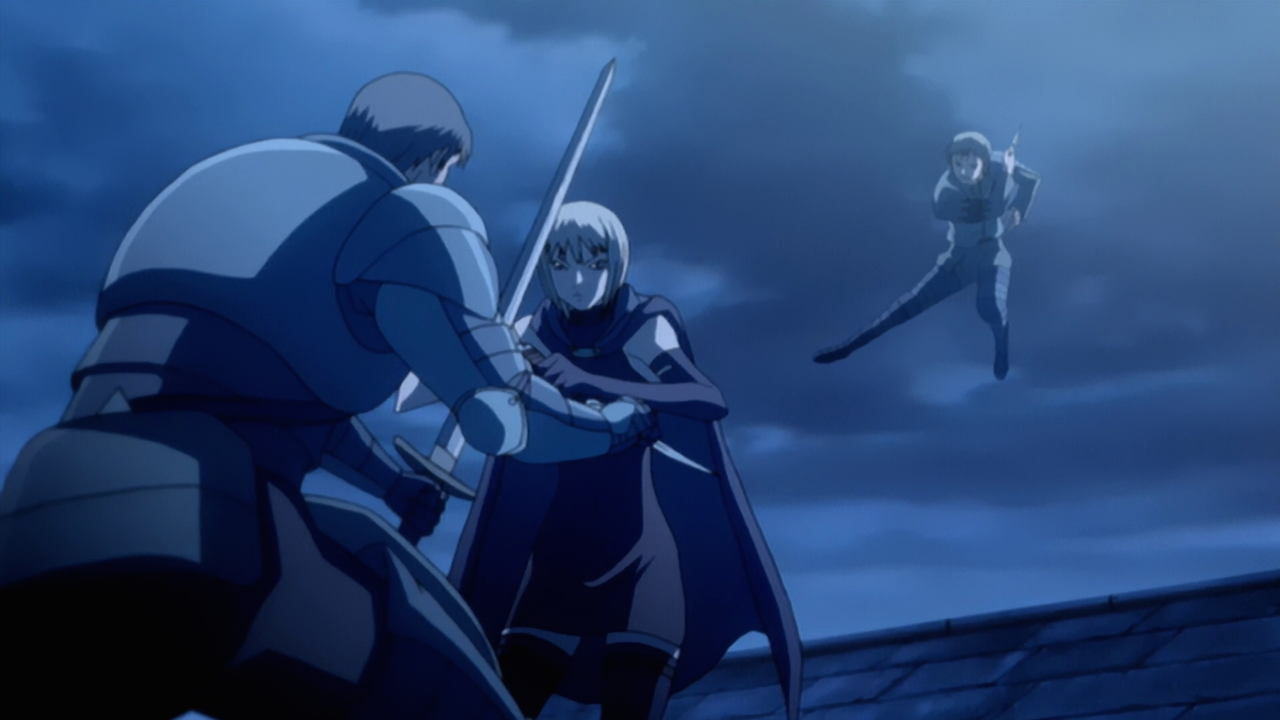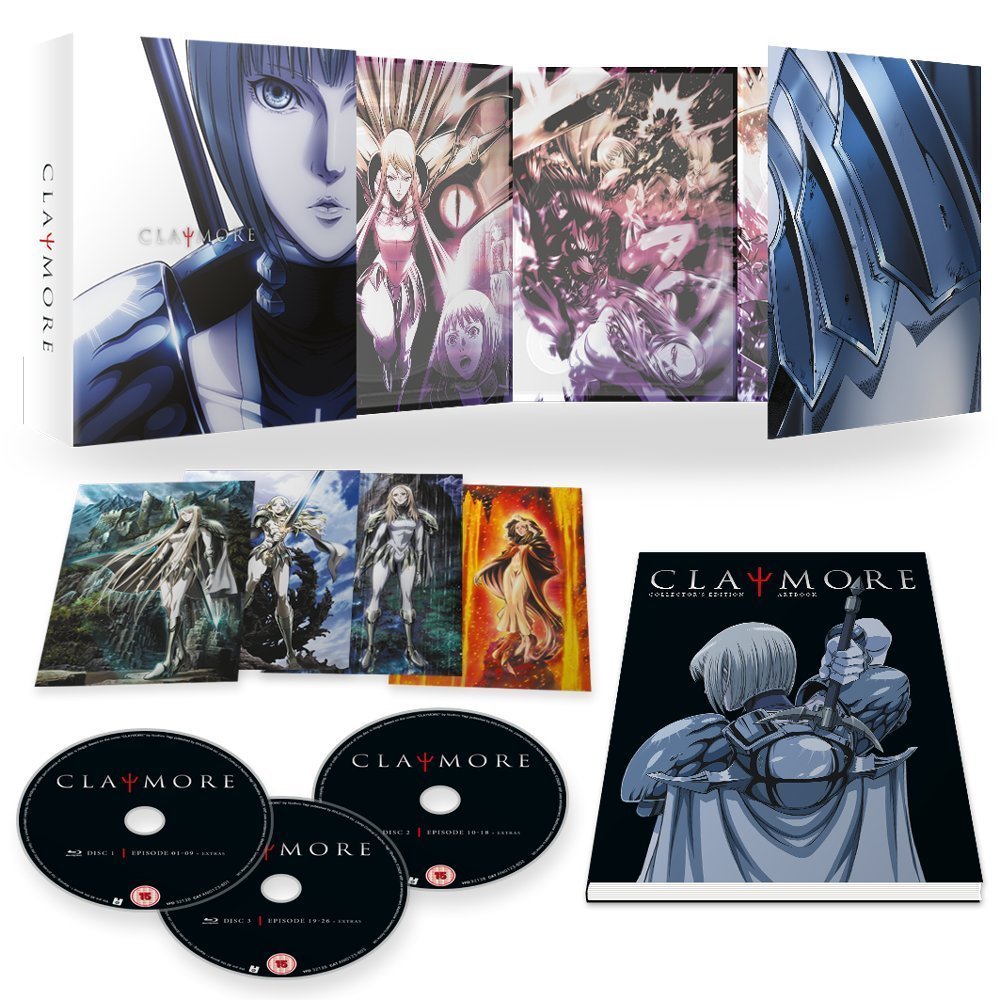Claymore Review
In a world where mankind coexists with a deadly race of demonic predators known as Yoma, a young woman named Clare works on behalf of an organisation that trains young female Yoma halfbreeds into warriors. These warriors are named Claymores after the gigantic swords they carry on their back, and although they are shunned by humanity, they are deemed a necessity. After a routine mission killing Yoma in a small village, Clare meets Raki, a young boy who lost everything in a Yoma attack, and decides to take him under her wing, despite her dangerous line of work.
Claymore, based on the manga of the same name by Yagi Norihiro, is a series that I feel occasionally gets treated a little bit unfairly. With its protagonist wielding a large sword, the supernatural medieval setting and elements of tragedy, comparisons with the massively popular 90s classic Berserk are pretty inevitable, and that is a high standard that it simply cannot live up to. When you nix the comparisons, however, and take it on its own merits, Claymore is still a very enjoyable show with a lot to offer.
Despite the fact that I did end up liking Claymore a lot, I’ll be the first to admit it doesn’t really offer a brilliant first impression. Going by the first four episodes alone, you wouldn’t be blamed for thinking that the whole series is going to be a somewhat formulaic affair, with each episode not having much more to it than Clare going to a new place and killing a few Yoma; rinse and repeat. Whilst these initial episodes do offer important nuggets of world building and lore, such as how exactly Claymores work and the rules of the organisation they work for, there isn’t really a whole lot to them. This changes from the fifth episode onwards, however, which is where the story really starts, or at least, where it starts to get interesting. Whilst the general focus is still on monster slaying, it’s from here where they start varying the situations and upping the ante which prevents things from getting stale. Also aiding in keeping things fresh are the variety of creature designs for the more powerful Yoma, known as awakened beings. To put it plainly, the designs for the awakened beings are really cool- looking and unique, which is something I really appreciate.
As you might imagine with a central premise based around killing monsters, Claymore is incredibly action-centric, which is a bit of a double- edged sword. On the one hand, the fights on display here are excellent, with a ton of memorable and bloody battles that will probably be the main draw of the series for most viewers. On the other hand, I think that there is such a thing as too much action, so when you’re watching the episodes back-to-back, all of the action can get a little bit draining. There are a few episodes where the pace slows down a bit, and we get a break from all the fighting, giving us insight into the characters’ histories and their motivations for becoming Claymores, but these are few and far between.
One thing I did like about Claymore was the ending. As many anime fans know, adaptations of ongoing manga or novels can often suffer from unsatisfying endings due to the source material carrying on past the anime, not leaving much room for closure, but this isn’t really the case here. Well, it sort of isn’t, anyway. Although the anime’s ending is incredibly open, I feel as if the main through-line of the series had a somewhat satisfying conclusion. It isn’t perfect, but given that the manga didn’t end until seven years after the series, I think the writers did the best they could with what they had.
Claymore’s protagonist, Clare appears stoic and rather dull at first but from Episode 5 onwards, we find out a lot more about her and her motivations for becoming a Claymore. This adds some depth to her character as well as making her more likable. Unfortunately, Clare is just about the only fleshed-out character in the whole show.
The supporting cast largely consists of Clare’s fellow warriors, but they are all rather forgettable, being mild variations on ‘badass action girl’ and not a whole lot else. We do get some brief insight into these characters, but it isn’t much. Given that there are 26 episodes, and the insane amount of action, I think it’d have been nice to have seen some of the more drawn-out battles shortened in order to give some supporting characters like Helen or Deneve a bit more backstory or development.
Of all the characters in Claymore, there was only one that I actively disliked, and that was Clare’s companion Raki. I find it somewhat hard to pinpoint exactly what I disliked about him, but I think a lot of it may have been down to the awful performance of his English voice actor, Todd Haberkorn. This is somewhat surprising to me, because I know Haberkorn is actually a good voice actor, and I didn’t mind him at all in others shows I’ve heard him in such as Sword Art Online and Fullmetal Alchemist Brotherhood, but here he just comes off as incredibly whiny and obnoxious, and his voice just grates on my ears. Thankfully, he’s only in about half the show, disappearing whenever Clare has to go off and fight Yoma, but when he was on screen, he did nothing but irritate me. Another complaint I have about Raki is his relationship with Clare. Despite only knowing her a short amount of time, he quickly becomes borderline obsessive over her, which just doesn’t feel natural given that the two characters haven’t exactly been together long, and have very little in the way of chemistry.
Todd Haberkorn’s rather atrocious turn as Raki aside, the rest of the English dub for Claymore is very solid, with an almost exclusively female cast full of great actresses you’ll likely recognize. Among the cast are Cherami Leigh (Digimon: Digital Monsters, Fairy Tail, Psycho Pass), Caitlin Glass (Baccano!, Love Live!, Danganronpa: The Animation), Jamie Marchi (Free!, High School DxD, Panty and Stocking with Garterbelt), Monica Rial (Assassination Classroom, Fullmetal Alchemist: Brotherhood, Full Metal Panic) and, possibly my all-time favourite voice actress, Laura Bailey (Persona 4: The Animation, Code Geass, K-On, Soul Eater). As well as a great voice cast, I also found Masanori Takumi’s score for the series to be brilliant, combining traditional orchestral arrangements with some kick-ass hard rock and metal tunes when the action gets going, that really pumps you up. The only real let-down, musically speaking, comes from the rather forgettable opening and ending tracks: ‘Raison D’etre’ by Nightmare and ‘Danzai no Hana~Guilty Sky’ by Riyu Kosaka.
Animation for Claymore is handled by a favourite studio of mine, Madhouse, who have produced many excellent shows such as The Tatami Galaxy, Death Note and HaNaYaMaTa. Whilst Claymore isn’t one of their most distinctive or unique looking productions, the animation here is still great, and it really comes into its own during the action sequences. Anime Limited’s release of Claymore is the first time the series has been available on Blu-ray in the UK, after being previously released on DVD only by Manga Entertainment. Being produced just before the era of HD anime, this Blu-ray release in an upscale, meaning that it doesn’t look quite as nice as new anime, but still looks quite a lot better than the DVD release before it, despite some banding issues when things get dark.
As per usual for Anime Limited, this new release of Claymore on Blu-ray is a treat for collectors. As well as coming in a high quality rigid box with a gorgeous digipak and art cards, this release also includes a 100 page artbook, full of character art, backgrounds, and, my personal highlight, art of all the Yoma that appear in the show. On-disc extras are also plentiful, including numerous commentary tracks by the English dub cast, as well as interviews with the Japanese staff, TV spots and, of course, a clean opening and ending.
In Summary
Claymore is not a show without its faults, but the excellent action sequences, top-notch animation, and awesome soundtrack more than make up for any shortcomings it may have, and is well worth a watch.








